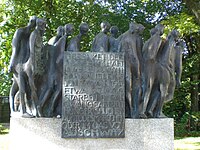
Kaufering concentration camp complex
Kaufering was a system of eleven subcamps of the Dachau concentration camp which operated between 18 June 1944 and 27 April 1945 and which were located around the towns of Landsberg am Lech and Kaufering in Bavaria.
Kaufering I–XI
Previously, Nazi Germany had deported all Jews from the Reich, but having exhausted other sources of labor, Jews were deported to Kaufering to create three massive underground bunkers, Weingut II, Diana II, and Walnuss II, which would not be vulnerable to the Allied bombing which had devastated German aircraft factories. The bunkers were intended for the production of Messerschmitt Me 262 aircraft, but none were produced at the camps before the United States Army captured the area.
Kaufering was the largest of the Dachau subcamps and also the one with the worst conditions; about half of the 30,000 prisoners died from hunger, disease, executions, or during the death marches. Most of the sites were not preserved and have been repurposed for other uses.
As Allied troops approached, rumors circulated among the prisoners that the Germans were going to massacre them before liberation. In mid-April, SS general Ernst Kaltenbrunner relayed orders from Adolf Hitler for the Luftwaffe to bomb Dachau, Landsberg, and Mühldorf, which all had high Jewish populations. The Gauleiter of Munich, Paul Giesler, ordered Bertus Gerdes, administrator of Upper Bavaria, to prepare plans for the extermination of the surviving prisoners. Gerdes prevaricated, citing the lack of airplane fuel and ammunition as well as poor weather. In response, Kaltenbrunner ordered that the Kaufering prisoners be taken to Dachau main camp, where they were to be poisoned. Gerdes ordered a local doctor to prepare poison, but this plan could not be implemented either. The third plan was to take the prisoners to Ötz Valley in the Alps, where they were to be murdered "in one way or another".[38]
According to German records, 10,114 prisoners, including 1,093 women, were at Kaufering camps during the last week of April. Most of them were evacuated to Dachau or locations further south, either on foot or by train.[10] Prisoners faced a difficult choice of whether to join the death marches or to try to stay behind, knowing that they might be massacred. On the death marches, anyone who could not keep up was beaten or shot, leading to many deaths.[39][2] The evacuation was disorderly, and many prisoners succeeded in escaping during the roundups at the camp or later, when the columns were attacked by American aircraft.[40] On 23 April, 1,200 prisoners left Kaufering VI (Türkheim) on foot and joined the prisoners forced on a death march from Dachau's main camp. Another 1,500 prisoners left Kaufering the next day, proceeding at first on foot and later by train. On multiple occasions, the prisoners were attacked by Allied aircraft. In one of these attacks, which hit a train carrying ammunition as well as prisoners, hundreds of victims were killed. Some of the prisoners evacuated from Kaufering ended up at Allach concentration camp.[10]
Hundreds of the evacuees from Kaufering arrived at Buchberg labor camp (south of Wolfratshausen) on 29 April. Otto Moll, a functionary of Kaufering, attempted to massacre these prisoners but was foiled by the camp commander. Instead Moll killed 120 or 150 Russian prisoners from Buchberg.[41] Many of those who left Kaufering were liberated at Dachau on 28 April, but others were forced to march southwards into Upper Bavaria and were not freed until May. Kaufering IV, where those incapable of walking were held, was set on fire on the orders of the SS doctor, Max Blancke.[33] Hundreds of sick and emaciated prisoners were trapped inside and killed. Shortly afterwards, Blancke committed suicide.[21]
In popular culture[edit]
The liberation of Kaufering IV was depicted in the second half[57] of Episode 9 "Why We Fight" of the TV mini-series Band of Brothers, a dramatization of E Company, 506th Infantry Regiment, 101st Airborne Division.[58][59] Although it was filmed in Hertfordshire, England, the episode is a realistic recreation of actual events depicted in historic photos and newsreels. For example, the soldiers have to confine the prisoners to the camp because there is not enough medical care available, and German civilians are forced to bury the dead. The American soldiers, who had previously fought from a parachute landing on D-Day through France and Germany, have become disillusioned, but confronting the horrors of the Nazi regime reminds them why they are fighting the war. Commentators rate the episode as one of the best of the series.[58][57] American writer J. D. Salinger, the author of Catcher in the Rye, was one of the liberators of Kaufering IV.[60]
Austrian psychiatrist Viktor Frankl was deported from Theresienstadt to Kaufering via Auschwitz in October 1944; he spent five months in Kaufering III and was transferred to Kaufering VI in March 1945.[61][62] His 1946 memoir, Man's Search for Meaning, has sold more than ten million copies and been translated into 24 languages.[63] Large parts of the book are purportedly set in Auschwitz, where Frankl spent only three days, but actually depict his experience at Kaufering.[64] In the book, Frankl develops his theory of logotherapy and argues that prisoners who maintained a positive attitude were more likely to survive. His work has however not been positively received by Holocaust historians, who maintain that Frankl's theories do not explain why some prisoners survived and others did not.[65]






